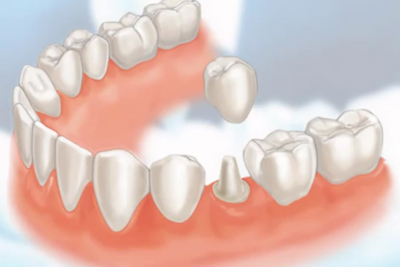Dental Crowns and Bridges
Dental Crowns and Bridges in Lawrenceville
At Sequoia Smiles, we use cutting-edge technology to create long-lasting crowns and bridges.
What is a Dental Crown?
A crown is a tooth-shaped “cap” that is placed over a tooth to restore its appearance, strength and function.

Dental Crown FAQ's
Dental crowns are recommended for the treatment of fractured or cracked teeth, as well as to help hold a dental bridge in place. Crowns are also used to cover discolored or misshaped teeth.
Dr. Vinh will diagnose your oral health issues and help you decide if one or more dental crowns may be appropriate for your treatment. He will then prepare the tooth by removing any decay or weakened tooth structure. Next, he will take a digital scan or impression of your tooth to send to the lab. For about two weeks, you will wear a temporary crown while your final crown is being processed. You will return at the final appointment to have your final crown seated examined for proper fit, function and esthetics. Then Dr. Vinh will bond the crown into place with dental cement.
While a crown can certainly protect the tooth against wear and tear, no tooth is indestructible. It is advisable that patients maintain proper oral home care and return for periodic exams and cleanings. In addition, be wary of other behaviors that might damage the dental crown, such as grinding and clenching, and eating hard, brittle foods.
Dental crowns and bridges are two of the most common restorative dental procedures performed today. A crown, also known as a cap, is a type of dental restoration that fully encases the tooth or dental implant. Crowns are often used when a large cavity threatens the health of a tooth. They are typically bonded to the tooth using dental cement.
A dental bridge, on the other hand, is a type of dental restoration used to replace one or more missing teeth. The bridge spans the area where the teeth are missing and is cemented to the natural teeth or implants surrounding the empty space. These teeth, called abutments, serve as anchors for the bridge. A replacement tooth, called a pontic, is attached to the crowns that cover the abutments.
Dental crowns and bridges serve both functional and aesthetic purposes. You might need a dental crown for several reasons. These could include protecting a weak tooth from breaking, restoring an already broken tooth, covering and supporting a tooth with a large filling, holding a dental bridge in place, or covering a dental implant.
A dental bridge is recommended if you’re missing one or more teeth. Gaps left by missing teeth can cause the remaining teeth to shift, which can result in a bad bite. Bridges help prevent this from happening.
Modern dental crowns and bridges are designed to blend in seamlessly with your natural teeth. They can be made from a variety of materials, including porcelain, porcelain fused to metal, or ceramic. These materials can be matched to the color of your natural teeth, making the crown or bridge virtually indistinguishable from your natural teeth.
With proper care and maintenance, dental crowns and bridges can last a lifetime. However, they do sometimes come loose or fall out. The most important step you can take to ensure the longevity of your crown or bridge is to practice good oral hygiene. This includes brushing with fluoride toothpaste twice a day, flossing daily, and seeing your dentist or dental hygienist regularly for checkups and professional cleanings. In addition, avoiding chewing hard foods, ice or other hard objects can help prevent damage to your crown or bridge.
Getting a crown or bridge typically requires two dental visits. During the first visit, your dentist will prepare the affected teeth by removing decay and shaping them to properly fit the crown or bridge. Impressions are then taken and sent to a dental laboratory where your restoration will be custom-made. You’ll receive a temporary crown or bridge while waiting for the permanent one. At your second visit, the temporary is removed and the permanent crown or bridge is carefully checked for fit and appearance before being cemented in place.
Several materials can be used, each with their own advantages:
- Porcelain/ceramic: Most natural-looking, ideal for front teeth
- Porcelain-fused-to-metal: Combines strength and aesthetics
- Gold alloys: Extremely durable, ideal for back teeth
- Base metal alloys: Strong and corrosion-resistant Your dentist will recommend the best material based on factors like tooth location, gum tissue position, and your personal preference.
